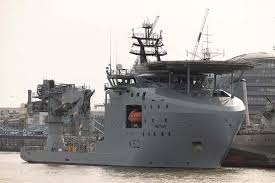Italy looks for second-hand OSV to fulfil underwater surveillance multi-purpose ship requirement

Rome: The Italian MoD Naval Armaments Directorate (NAVARM) has published a market survey request in mid-July 2025 for the procurement of a second-hand Off-Shore Supply Vessel (OSV) to be used as a “Multi-purpose vessel for underwater dimension surveillance” or Unità Polivalente per la Sorveglianza della Dimensione Subacquea (UPSDS) and delivered to the Italian Navy by end of February 2026 or within 120 calendar days from contract activation. The estimated value of the supply/service is €50 million (VAT exempt).
“Featuring high operational flexibility and rapid reconfigurability,” the primary mission of the UPSDS will the operations with “deployable underwater— whether autonomous or remotely operated — and surface assets” of the Italian Navy (Marina Militare Italiana, MMI). No further details were released on the requested mission and vehicles to be embarked, but if the procurement will be completed, it will be the first platform dedicated to unmanned vehicles to survey and operate on the national underwater infrastructure and underwater environment with other national agencies.
The procurement procedure is to identify the suitable vessel from the second-market in accordance to the features required by NAVARM, the conduction of any necessary maintenance/upgrade/modification work at a domestic shipyard by the ship supplier to make it suitable for the envisaged missions, ensuring interoperability with other Italian Navy in-service platforms, ports logistics and support; supply of equipment and documentation as well as services for hand-over and first operational deployment (in cooperation with a classification society), alongside training courses for crew and shore-based operators and maintainers, if required.
According to the same request, the supplier must hold the design authority of the vessel being acquired. The supplier must also have the capability to overhaul the systems onboard the vessel in compliance with and under the authorization of the relevant design authority (original manufacturer – OEM). The second-market OSV which has to have a mandatory IACS – OSV classification requirement, should have in a descending priority list:
a working deck of at least 560 sqm;
a crane with a 40-tonnes at 10 meters arm, at least 500 m of cable and anti-heeling system;
a platform beam of 18-22 meters;
a year of construction ≥ 2015;
a DP2 minimum dynamic positioning class;
a draft of less than 7 meters;
an overall length (LOA) of 75-110 meters;
an integrated propulsion and electric power generation system (IFEP type);
accommodations with at least 60 berths;
an endurance at 11 knots ≥ 4,000 nm;
a minimum deck load capacity of ≥ 5 tonnes/sqm and ≥ 500 tonnes in total;
a maximum speed of over 11 knots.
The NAVARM also indicated desirable requirements which could positively influence the selection of the platform. They include in a decreasing order of priority: the presence of a moon-pool opening onto the working deck; a secondary crane; the supplier’s willingness to carry out adjustments/modifications/additional supplies upon request, – not strictly related to meeting minimum requirements -, within the estimated maximum contract amount; the provision for moon-pool installation; the possibility of early boarding of MMI personnel during the possible transfer of the vessel to the national site, to facilitate the hand-over with the support of current civil crew; the presence of a flight deck (helipad), and the Diving Support Notation – ROV.
According to the NAVARM request, the interested party should have responded in 21 days – by early August (the procedure is not a tender) – and the UPSDS, purposely maintained, should be ready for delivery to Italian Navy by February-end 2026, or in any case within 120 days from contract activation.
With the same document, NAVARM has identified Fincantieri company as the supplier capable to fulfil the request in the stated timeframe, able to ensure configuration control of installed plants/systems and the use of upgraded parts interchangeable with the original ones; capable to guarantee performance with the required technical and quality standards, has the resources necessary to design “turnkey” adaptation works to bridge any knowledge and technical gaps between the commercial vessel configuration and the desired final UPSDS configuration; owns the know-how, equipment, and documentation necessary for performing the adaptation works from the commercial platform to meet Italian Navy requirements, among others.





